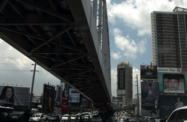The Philippines has kicked off its 2018 infrastructure programme with the launch of a headline transport project, and additional investments are set to support GDP growth moving forward.

In early January ground broke on the P31.3bn ($616.5m) South-east Metro Manila Expressway project, also known as the C6 Expressway, which will run along the outskirts of the capital, linking Taguig City with Quezon City.
Targeted for completion in 2020, the 34-km, six-lane toll road is expected to cut travel time along the route to around 30 minutes. The project should also help improve logistics efficiency and ease congestion on nearby arteries.
The C6 project forms part of a broader P8.4trn ($165.1bn) investment programme that aims to lift infrastructure development spending from 5.4% of GDP in 2017 to 7.4% in 2022, according to Benjamin Diokno, the budget secretary. Analysis by investment banking services firm First Metro Investment expects outlays to reach 6.1% of GDP this year.
Build, Build, Build programme focuses on transport
A major project to be launched this year as part of the Build, Build, Build programme is the Metro Manila Subway, the country’s first underground mass-transport system.
The 13-station development, which has an estimated price tag of P355.6bn ($6.9bn), aims to significantly cut travel time around the city, and is expected to carry some 370,000 passengers annually upon its partial opening in 2025. Construction is being part financed by the Japan International Cooperation Agency (JICA), the Philippines’ main international aid agency partner, which is set to provide JPY1trn ($9.2bn) for development over the next five years.
In addition to the metro, other key projects in the pipeline include: the Luzon Spine Expressway Network, a series of new roads stretching 1000 km from north to south Luzon; the Metro Manila Logistics Network, a set of new bridges and roads designed to alleviate congestion in the capital; and the 74-km Metro Cebu Expressway, which is expected to halve the travel time between Naga City and Danao City.
Infrastructure gaps have long been identified as a barrier to growth. Although the Philippines ranked 56th out of 137 economies on the World Economic Forum’s Global Competitiveness Index 2017-18, it ranked 97th for infrastructure, with shortfalls identified as the second-most problematic factor for doing business, behind inefficient government bureaucracy.
The accelerated infrastructure investment programme will be one of the key forces driving GDP growth in 2018, according to Gil Beltran, under-secretary and chief economist at the Department of Finance (DoF). Together with tax changes and rice sector reform, the Build, Build, Build policy “will push the country’s growth to 7-8% this year and sustain manageable inflation”, he said.
Tax reforms to help fund development
The increase in infrastructure investment will be supported, in part, by new tax reforms, which the DoF has forecast will generate P786.4bn ($15.5bn) over the next five years.
The first of these, the initial stage of the Tax Reform for Acceleration and Inclusion (TRAIN), introduced in early January, increased excises on fuel, vehicles, tobacco and sugared drinks, while at the same time reducing personal income taxes. In total, TRAIN is expected to fund around 25% of Build, Build, Build.
The government has also proposed tapping the international bond market, particularly in Japan, China and South Korea, for financing. In early January Carlos G Dominguez III, the secretary of the DoF, told reporters the government planned to launch a bond offering in the first quarter of the year. He added that a samurai bond issue was being considered for later in 2018.
Manufacturing tipped for rebound
Aside from providing an overall economic boost, the infrastructure rollout is expected to benefit key sectors that have fallen behind the general trend of strong expansion.
Manufacturing, which has felt the weight of higher electricity prices and a lack of supply chain development, is one such example. The Volume of Production Index contracted by 8.1% year-on-year in November, the third successive month of negative growth, according to data from the Philippines Statistics Authority.
However, this decline could be reversed if infrastructure works stimulate domestic growth.
“Infrastructure development is likely to ramp up thanks to President Rodrigo Duterte’s infrastructure development programme, and that should help the production of key inputs such as cement,” a January report from financial services firm Moody’s Analytics said.
Programme could alter balance of payments
While the fast-tracked infrastructure programme is expected to support growth in many parts of the economy, one short-term downside could be the potential impact on the balance of trade.
The accelerated rollout of infrastructure projects has seen related spending rise significantly in recent years, which has led to contractors increasing imports of construction products and associated equipment.
The balance-of-payments deficit reached $1.8bn in the year to November, according to the Bangko Sentral ng Pilipinas (BSP), more than eight times the $206m deficit recorded for the same period in 2016, with infrastructure-related imports seen as one of the major contributors.
Although the balance of payments has moved into the red and there are concerns inflation could rise on the back of shortages in key materials or skilled labour, officials remain confident that this will be offset when capital-goods imports begin to make a positive impact on the economy through increased GDP, investment and employment.


